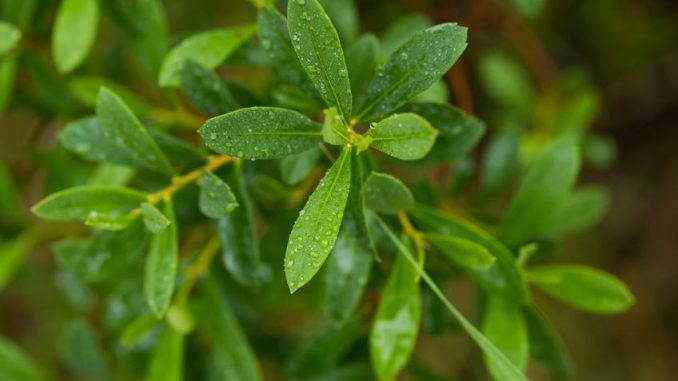
The Bog Myrtle or Sweet Gale (Myrica gale L.) is a plant of the high moorlands of Northern Europe and once an important ingredient of beers and ales because of its bitter and purgative properties. It is a low deciduous woody shrub which dominates many heathland areas thriving on acid bogs with sandy soils.
It is thought the ancient Scandinavians – the Vikings, flavoured their beer with bog myrtle where it was known as ‘heath-beer’. It must have been highly aromatic (Locke, 1859). Behre (1998) describes its use in the river Rhine area of Northern Netherlands based on archaeological findings. This understanding of the use of herbs in brewing was also based on similar finds around Northern Ireland, North England and Scotland as well as Northern Europe and Scandinavia itself. Nelson (2005) reports that a birch bark bucket was found in Egtved, Southern Jutland in Denmark that contained ‘traces of lime, meadowsweet and white clower pollen, wheat grains, sweet gale, cowberry, and cranberry’. This particular beverage was stated to be of honey, wheat and berries – all fermented. Such beers were becoming relatively sophisticated brews where sugar was available for natural yeast fermentation.
Hildegaard de Bingen, the Abbess was well versed in brewing, first reporting the use of bog myrtle in beer in the 1100s. Hops had also been used in a variety of beers at the same time as other herbals and gradually replaced them (Robinson, 1994). In later medieval times, Sweet Gale was used by peasants or during hop shortages in Sweden for example (Viklund, 2011). Virgo (2010) gives a good account of its use especially with reference to the antimicrobial properties of Sweet Gale infusions. Shelf-life of beer was especially important to those who needed potable ‘water’ and a reliable source as such. Hops probably took over because the stability of beer using other herbs was not as secure and there were probably toxic side effects. The use of relatively safe herbs would have been tainted by food poisoning episodes where other extracts had been tried.
Bog myrtle beer is still available – brewed apparently near Floro on the west coast of Norway and there is a slow return to such beer types. Along with the use of other herbs, there may be a return to these products in the forthcoming decade as craft brewers seek novel flavours with a long tradition and marketable back story.
If you would like to know more about what this ingredient would do for your products then please call FoodWrite Ltd. on tel: 07714101039. Look forward to hearing from you !
References
Behre, K.-E. (1999) The history of beer additives in Europe – a review. Vegetation History and Archeobotany, 8, pp. 35–48.
Locke, J. (1859). On the” Heath-Beer” of the Ancient Scandinavians. Ulster Journal of Archaeology, 7, pp. 219-226.
Nelson, M. (2005). The barbarian’s beverage: A history of beer in ancient Europe. Routledge. p. 12
Robinson, D. (1994). Plants and vikings: everyday life in Viking Age Denmark. Botanical Journal of Scotland, 46(4),pp. 542-551.
Viklund, K. (2011). Beer Brewing in Medieval Sweden–archaeobotanical and documentary evidence. Processing, storage, distribution of food. Food in the medieval rural environment. Ruralia VIII, Brepols, pp. 57-75.
Virgo, G. (2010). Traditional Scandinavian Beer Brewing: Microbial Inhibitory effect of Myrica gale and Rhodondendron tomentosum. ***
Leave a Reply